
|   |

|   |
 e-mail: ukb7@rediffmail.com Choreographic foray: Contemporary, classical Photos courtesy the artistes December 25, 2019 End-November and early December saw quite a pleasant outburst of choreographic creativity in the eastern metropolis, on both classical and contemporary fronts. While Kathak brought out a novel linkage with Baul singing of the village Bengal, Odissi saw a wonderfully vivid tryst of the women dancers with their inner domain, alongside gorgeous sets and subliminal illumination. On one side, Bharatanatyam went back to the Upanishad mooring of Satyam, Jnanam, Anantam; on the other side was an exhilarating contemporary exploration with "hugging the floor", in a near literary sense. To cap it all, there was an inner, extrapolated journey of classical dance visualized in a sumptuous stage. All in all, the exhilaration induced a euphoric sense of joy with a nip in the air, to match! Kathak Festival 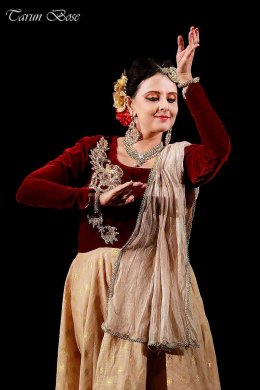 Alokparna Guha 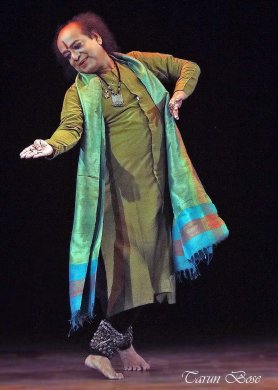 Ashim Bandhu Bhattacharya Ashim Bandhu Bhattacharya, a very senior dancer of both Jaipur and Lucknow gharanas and an established guru, followed next with Adi Shankaracharya's Nirvanastakam, an old text of 8th century: "I am the Brahma... I am nowhere and I have nothing... but I am in every element, every emotion and every relationship... I am the only one, Shivoham Shivoham"... Then came his Mel Bandhan, presenting elements of both Jaipur and Lucknow styles of Kathak and weaving together the crisp footwork of lari, chakkars, jhati padhant and anga abhinaya. His concluding item was a brilliant abhinaya based on Baul Sangeet of rural Bengal: I wonder how the unknown bird within the cage marks its entry and exit..., set in an innovative and experimental stage-set to give the message on union of body and soul.  Madhumita Roy The final dancer was Madhumita Roy, a disciple of Pt. Birju Maharaj. She presented technical Kathak in vilambit teen taal with bandish: Kahe maan koro atiri ab... in raga Madhuvanti. She then resumed technical Kathak with three padhants in taal Thunga and tihai in drut teen taal, very reminiscent of Pt. Birju Maharaj. She concluded the evening with abhinaya to a sorrowful ghazal: Tanha khud se baatein koru... Excellent musical support for all three programs was provided by Debashis Sarkar on vocal, Subir Thakur on table, Sunondo Banerjee on sarod, and Ranjani Bhatacharjee on bol parhant. Satyam Jnanam Anantam!  Presented on December 2 by 'Malashree', the program was built around an elaborate theme, as explained by the organizers: "The Supreme Soul is the absolute, the unique, the omnipresent, where all pervading energy and owner of energy are one and the same. Human soul is only the Supreme Soul having an embodiment -- a coverlet. Human soul goes on changing the coverlet -- the deceased body through life cycles of birth, growth, decay and extinction and then rebirth." This was redolent of Srimad Bhagavad Gita's great teaching: Vasangsi jirnani yatha vihaya nabani grinhati naroparani / Tatha sharirani vihaya jirnan nanati sangyati nabani dehi... With overall direction and concept by Arpita Venkatesh - disciple of guru Aloka Panikkar and with a Masters in dance from Rabindra Bharati University -- and Kathak segment directed by Sampita Chatterjee, the transcendental life-cycles of birth, death and rebirth were visualized in the performance as embedded in, and influenced by, the Panchbhoota (the five basic elements): Kshiti, Apa, Tejas, Marut and Vyom. In the overall composition, the pulse of Panchabhoota kept on resonating within the Jeevatman, to the tune of ragas Hamsadhwani, Yaman and Charukeshi. Kshiti is Earth that holds us, provides us shelter, food, nutrition and has a motherly nature, since various life forms generates out of it. Dancers related Kshiti to the phases of birth and infancy in all life; just as a mother holds the fetus within her, nourishes it, gives birth, and raises the baby by removing all obstacles, so does our Mother Earth. The choreography used a form close to earth, that is, ebullient folk form from which Odissi had its genesis, supported by ragas Tilak Kamod and Kalashree. Apa is Water with the unique property of moving from a height to a lower level, with a fluidity sans bounds. The dancers elaborated the adolescence metaphor of our life where we dive into the unknown without much thought. The adolescent's innocence, playfulness and exuberance were compared to the free flow of the waters. The dancers resorted to Pallavi in raga Khamaj in Odissi's languid postures of torso and multiple bhangis, with raga Megh. 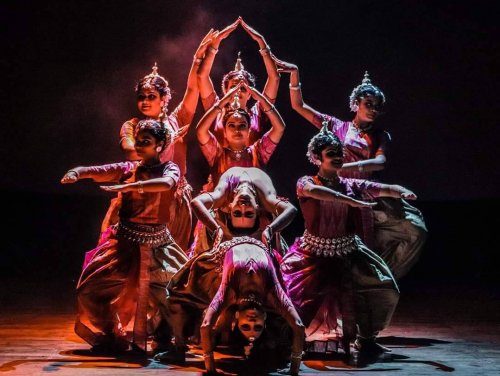 Tejas is Fire that bears comparison to youth: the prime of life where we shine brightly, and our inner conscience and outer behavior holds patterns of rebellion, questioning the status quo. The choreography here used innovative steps, incorporating movements from martial arts as well as sticks as props to depict the rebels within us. In parallel, the youth was coloured by mutual attractions, romantic coupling and conjugal bliss. Odissi abhinaya was seen with sawal jawabs in music to bring out the male and female bonding. It was predominantly sringara based abhinaya to raga Bairagi. While the mood of rebellion was captured by mnemonics on pakhawaj, romance was highlighted with raga Kirwani. As the heat of fire eventually dissipates, so do the carnal desires. The commentator highlighted that there is something more than this mundane, materialistic and physical attraction that plays a role in alleviating one's mind towards a permanent bliss and less of momentary pleasures. Perhaps there is a mystic realization towards the Supreme soul -- the omnipresent. Marut or Wind was compared to the crossroads of our lives. As this experience is something that is invisible though perceptible, so is the wind that remains unseen but only felt, ever moving towards a fulfillment. The choreography now incorporated Kathak known for its light mudras and quick chakkars to bring out the evanescent quality of Marut. Side by side, Odissi reflected the realization by the aged. It ended with a Kathak Tarana in raga Gaur Malhar. Finally, Vyom or Space signifies death and after-death journey. The visible life ends and the mortal body dissolves into space aligning back to the five basic elements. The commentator announced that while the mortal body is done away with, perhaps journey of the soul does not cease, only to reach the Supreme -- the unborn, the undying and the omnipresent. Thus, the cycle of birth-death-rebirth continues, which is the ultimate truth: Satyam Jnanam Anantam. Vyom is established only with aalaap with raga Bhatiar, Puriya Dhaneshree signifies death and raga Bhairavi intones the new path of soul. While the dovetailing of the multiple stages of life-cycle (a temporal concept) into the elements of Panchabhoota (a spatial concept) was certainly open to question, the total sincerity of the choreographic effort could be palpably observed. There was competent support from the script by Saradindu Mukherjee, music by Sukhamaya Bhattacharya and light design by Dinesh Poddar. Breaking Points Presented on December 4 by 'Sapphire Creations', this was primarily a presentation of what nine dancers - a mix of Sapphire Repertory members and Sapphire Academy students -- had acquired from a week-long residency there, led by Prashant More, a Bangalore based contemporary dancer, choreographer and teacher. More had combined training both in Bharatanatyam and contemporary dance, with B-boying and Hip-hop dances in his upbringing, and then launched a prolific career of numerous performances and productions all over the globe. 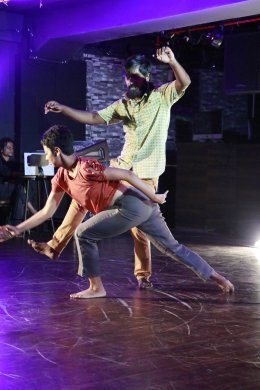 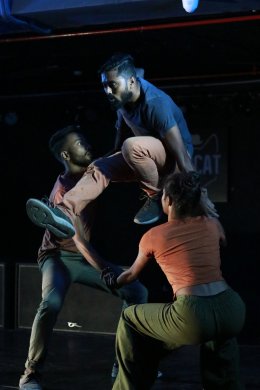 Breaking Points revealed a remarkable skill-set built around physical intelligence, by what was described as, "active de-constructing the prevailing movement vocabulary a dancer had and re-constructing a risk-based space for exploration." In effect, this led to an encounter of the physical challenges that pushed their bodies to go deep into their own existing dance language and then to step out of their body's comfort zones. The result was a demonstration of an intriguingly new skill-set of making highly contorted body-postures and paraplegic movements, tilting dangerously into inclinations before succor could reach, and moving speedily into zig-zag courses while retaining an aesthetic body balance. The dancers also evinced "Flying Low" techniques that was essentially horizontal extensions and vertical leaps, but bending low down and acquire supine status of diverse kinds avoided in conventional choreography. This focused mainly on the dancer's relationship with the floor, utilizing simple movement patterns, speed, alertness, awareness with space and other fellow dancers, and spirals that explored cohesion and expansion of the body. This was what would effectively constitute "floor-hugging" and - as was demonstrated, threw up unimagined possibilities to extend the reach of conventional choreography. As a performance, Breaking Points was conceptualized as: "a series of explorations and relationships between people, perceptions, memories, ideas and thoughts." In its physical manifestation, it was a highly focused execution of techniques and dancing grace. The coup de grace was Prashant More's own performance, 3AM. Choreographed by himself, it was about a situation faced by a chronic insomniac struggling with his sleeping disorder in many desperate ways. How he deals with his desperate need for some sleep in the small hours of night was made the theme of a hilarious choreographic take-off using mostly his own "Flying Low" technique which he elaborates as: "Lying on the bed with closed eyes, where the mind has check-in for multiple flights; floating in space like a cloud that has forgotten a way back home" and, indeed, a myriad other ways. It was a perfect illustration of "the hyper active mind filled with thoughts, ideas and anxiety, running back and forth into the past and future," as he put it. Antar-Yatra Presented also on December 4 by Odissi Vision and Movement Centre under the creative direction of Sharmila Biswas -- a senior disciple of guru Kelucharan Mohapatra with 45 years of illustrious performance behind her - it was a collaborative effort with three lead dancers: Lakshmi Parthasarathy Athreya in Bharatanatyam, Sreelakshmy Govardhanan in Kuchipudi and Shashwati Garai Ghosh in Odissi; accompanied by OVM's senior repertory dancers (Monamy Nandy, Rohini Banerjee, Tri Paul and Ankita Kulabhi). As Sharmila averred, "Artists have always seen this world with a different lens and they have understood reality only through this lens. Antar-Yatra brings the audience close to the inner domain from past to present of the women dancers of India, since today's dancers are inheritors to that legacy..." 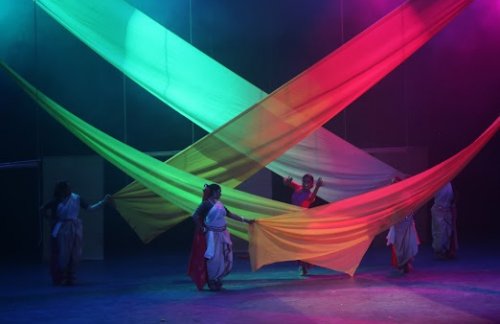 Harking back to the mythic age, the curtain opens on an arena swathed in blue glow when the lead dancers perform together to visualize the dancing and prancing Apsaras to whom all classical dancers trace their lineage. Soon the scene shifts to the historical times of Devadasis with the lead dancers draped in plain costumes, performing to the refrain: "... Lifelong bondage, endless freedom... wife of god...I am the chosen one... Allow me to write my name in your heart..." Sharmila enters with a life-sized puppet to the tune of Munnavane, a song that asks Devadasis the searching question: "When you have the lord opening his arms for you, would you still go after the ordinary man? When the magical world awaits you, would you still go after the mundane?" The scene transits now individually into a Kuchipudi Rasyatra, where Sreelakshmy takes over in a lilting sequence. Sitting depressed, she hears soft rhythms and brightens up. All at once, the dark stage is swathed with streaming yellow cloth strips hanging diagonally across and enveloped in yellow strobes. Sreelakshmy traipses in crisp footsteps rhythmically in between the drapes weaving her stunning visual tapestry. Colours and sounds play hide-and-seek and Lakshmi takes over with sprightly feet in a vigorous Tillana and enlivens her journey God-wards, inspired by sringara, as she loses herself in an all-enveloping creativity, springing from raindrops, animals, et al., until she finally sits still in a meditative Kundalini Chakra. In the Odissi segment, Saswati takes on her quest for the unattainable, a journey towards god that can be extrapolated as a dancer seeking to discover herself encircled by her companions in martial postures and wielding sticks. At the finale enters Sharmila herself - an elegant picture of utter austerity in the plainest of attires, and hangs, from the mid-stage standing screens, seven exquisite puppets of Krishna on a semi-dark stage to a soulful rendition of Vidyapati's lyric: Sundari kahe mohe sambhasi na jasi... The lead dancers, also sans gaudy costumes, mirror the meditative quiet. Together, they depict Radha's emotional surrender to Krishna in the Jayadeva ashtapadi, Sakhi he..."When the time comes, I will be waiting by the roadside, threading the garland which I started so long ago..." 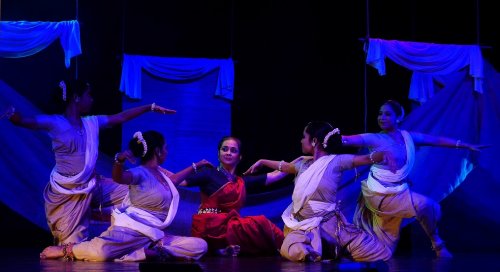 The beauty of the entire presentation was that it was throughout enlivened by a sub-text that kept interpolating the dancer's mindscape, constantly quizzing and questing as to who she was, whence she came and where she was leading to, weaving a mosaic of moods and moments with live figures from the backdrop commingling with the puppets and dancing companions up front - now with hand-held screens, now with drapery and figurines, and now with worshipful platters brimming with blossoms - always creating patterns and waves, and always hinting at an overwhelming magic that stayed with the spectators for long. In its final thirty-second version - after Antar Yatra having toured the whole of India and the USA - brilliant music composition and live singing by Srijan Chaterjee, most innovative lighting by Dinesh Poddar, utterly fascinating bamboo-and-mat sets and props by Nandagopal Jana, sound by Soumitra Das, and design by Debottama Sarkar, all rose to the occasion and contributed to the performance's well-deserved success!  Dr. Utpal K Banerjee is a scholar-commentator on performing arts over last four decades. He has authored 23 books on Indian art and culture, and 10 on Tagore studies. He served IGNCA as National Project Director, was a Tagore Research Scholar and is recipient of Padma Shri. Post your comments Please provide your name and email id when you use the Anonymous profile in the blog to post a comment. All appropriate comments posted with name and email id in the blog will also be featured in the site. |